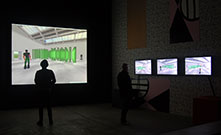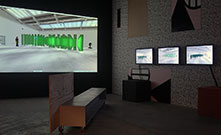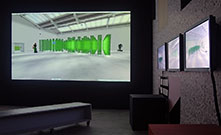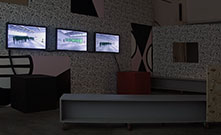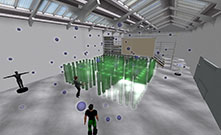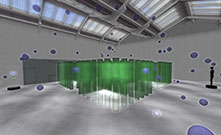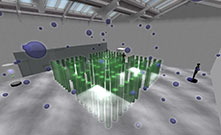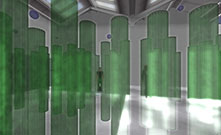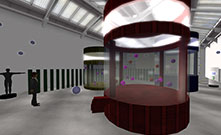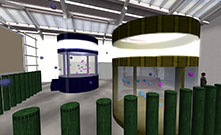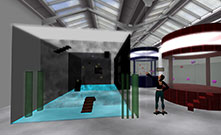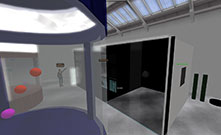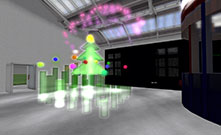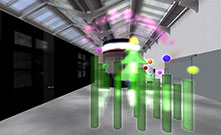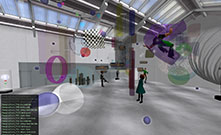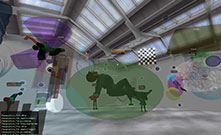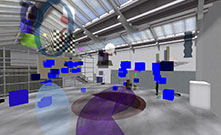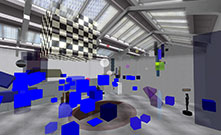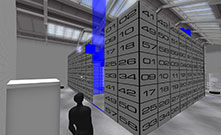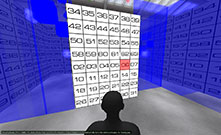Changing Room
v1.0 by: Michael Takeo Magruder with Drew Baker & collaborating artists, 2009
A mixed-reality installation exploring the mutability and reusability of artefacts, concepts and situations in the Digital Age.
About the Artwork:
Changing Room is an evolving artwork that considers the transitory nature of shared, virtual and mixed-reality environments and the creative potential of working within these liminal spaces. Blending the shared virtual environment of Second Life with the shared physical environment of Eastside Projects, the artwork facilitates the realisation, curation and documentation of distinct – yet interrelated – art projects arising from a common pool of virtual and physical resources. Over a seven-week period, a series of resident artists will be invited to use the spaces and materials to realise works of their own conceptual and aesthetic design. Each project will last for a single week, after which, it will be documented in situ and then be handed over to a new artist for repurposing.
The installation’s main virtual element is a set of 128 translucent green columns located within Eastside Projects’ gallery in Second Life. Each column is a single primitive object (prim) that can be fully modified using Second Life’s in-world toolset. Resident artists are provided exclusive rights to transform and programme these digital structures, but cannot generate their own objects within the space. If any of the artwork’s prims are deleted or removed from the area, a series of scripts will instantly regenerate them in their original, given state.
Situated in Eastside Projects’ second gallery, the artwork’s physical component is a constructed environment that has been fabricated using recycled materials collected from the gallery’s previous exhibitions. Live audio and video from the virtual gallery are streamed into the physical space through a group of Dolls (virtual bodies devoid of human agency that are used to ‘sense’ and transmit aspects of a virtual world). Visitors entering the gallery are tracked by a hidden motion sensor that relays its data to the virtual realm. The presence of spectators in the physical space causes translucent blue spheres, each having just a 12-hour lifespan, to be generated within the virtual world for resident artists to use.
Process:
The artwork’s initial configuration will be exhibited without alteration for a period of one week. Direction over the virtual and physical resources will then be relinquished to another artist who will be given exclusive access to remix and modify the spaces according to their own designs. At the beginning of each new week, control will be ceded to another resident artist, thus continuing the process.
At the conclusion of each artist’s session, photographic, video and textual documentation will be collected both virtually and physically. An exact copy of the permanent prims will be taken in order to archive a 3D ‘snapshot’ of that artist’s virtual creation, thereby serving as a record of the artwork’s main transitions. The archived copy will also be returned to the artist so that they can reinvestigate their work in other locations and times. Although each of the individual sessions will be intrinsically linked to the process as a whole, they will not necessarily be dependent on one another, so that artists’ works can persist and evolve according to their own trajectories after the project’s completion.
Materials:
Virtual: 128 permanent prims, (up to) 128 temporary prims, 4 plinths, 3 (avatar) Dolls and scripted control units.
Physical: reclaimed and recycled gallery constructions (walls, seating, structures, etc.), HD projector, 3 LCD screens, computers, custom-built motion sensor and 5.1 surround sound system.
Virtual/Physical Documentation:
Experience Version 1.0:
Virtual: 27 November 2009 until 24 January 2010, Transitional Space, Second Life: A Windows/Mac/Linux computer system running the current Second Life client is required to visit the shared virtual environment. A high-specification CPU/GPU, 5.1 or stereo audio, a colour display with ≥1024x768 resolution and a 1Mbps+ Internet connection are recommended.
Physical: 27 November 2009 until 24 January 2010, Eastside Projects, Birmingham, UK: Visit the shared physical environment alongside Liam Gillick’s new solo exhibition Two Short Plays, Thursday (12-7pm), Friday to Sunday (12-5pm).
With Projects by:
[ 23/11/2009 - 29/11/2009 ] initial configuration by Michael Takeo Magruder (as 'Takeo Takacs' & 'ChangingRoom Monday')
[ 30/11/2009 - 06/12/2009 ] session 1 by Antonio Roberts (as 'Overload Afterthought')
[ 07/12/2009 - 13/12/2009 ] session 2 by Selma Wong (as 'Selma Zeplin')
[ 14/12/2009 - 20/12/2009 ] session 3 by Wei Zhao (as 'Jovi Kenin')
[ 04/01/2010 - 10/01/2010 ] session 4 by Ana Benlloch (as 'Ana Vemo')
[ 11/01/2010 - 17/01/2010 ] session 5 by Iona Makiola (as 'Giggle Wurgle')
[ 18/01/2010 - 24/01/2010 ] session 6 by Lee Scott (as 'lee85 Unplugged')
Session Documentation:
In Collaboration with:
Drew Baker [ Second Life programming ] . Ana Benlloch, Iona Makiola, Antonio Roberts, Lee Scott, Selma Wong & Wei Zhao [ session artists ]
With Thanks to:
Gavin Wade [ curation ] . Gregory Sporton [ infrastructure ] . Robin Kirkham [ documentation ] . Hugh Denard [ discourse ]
Supported by:
Changing Room is an experimental prototype for EP:VV (Eastside Projects: Virtualised and Visualised) – an initiative seeking to develop online, multi-user environments promoting new models of artistic participation and representation within a gallery context. EP:VV is a collaboration between Eastside Projects, the Visualisation Research Unit, Birmingham City University and King’s Visualisation Lab, King’s College London, made possible through funding by Arts Council England.
Artwork Requirements:
Virtual: Windows/Mac/Linux computer system with the current Second Life client and stereo audio. A high-specification CPU/GPU, colour display with ≥1024x768 resolution and high-speed Internet connection are recommended.
Physical: reclaimed and recycled gallery constructions (walls, seating, structures, etc.), HD projector, 3 LCD screens, computers (with the Second Life client), custom-built motion sensor and 5.1 surround sound system.
